The Knights Templar Regalia has intrigued historians, collectors, and everyday people for centuries. From the humble white mantle with a red cross worn by the early Templars to the elaborate ceremonial attire utilized by contemporary fraternal orders, the regalia holds rich meaning.
This Blog Post Outline: Knights Templar Regalia examines where these clothes and symbols originated, how they were utilized, and why they remain potent today. By examining their history, symbolism, and cultural impact, you will understand why this regalia remains important.
Historical Origins of Templar Regalia
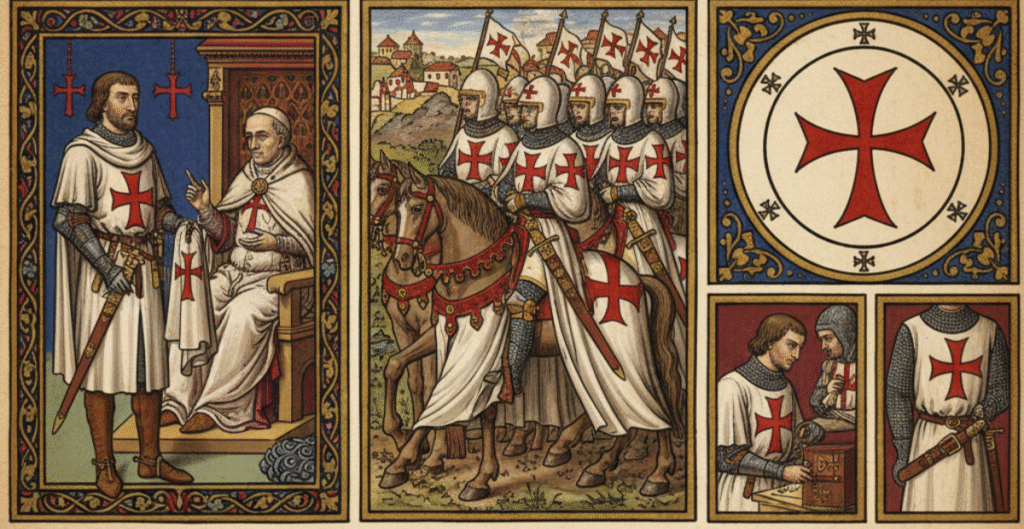
The story of Templar regalia begins in the early twelfth century when the Poor Fellow-Soldiers of Christ and of the Temple of Solomon were formed. Pope Honorius II officially approved the order in 1129, granting them the right to wear a distinctive habit. Their uniform became a mark of spiritual devotion and military duty.
The most famous part of the regalia was the white mantle, which symbolized purity and dedication to God. The red cross, added later, represented sacrifice and martyrdom. This simple but striking combination made the Knights instantly recognizable across Europe and the Holy Land. It was not just clothing but a statement of faith.
Key Elements of Traditional Templar Regalia
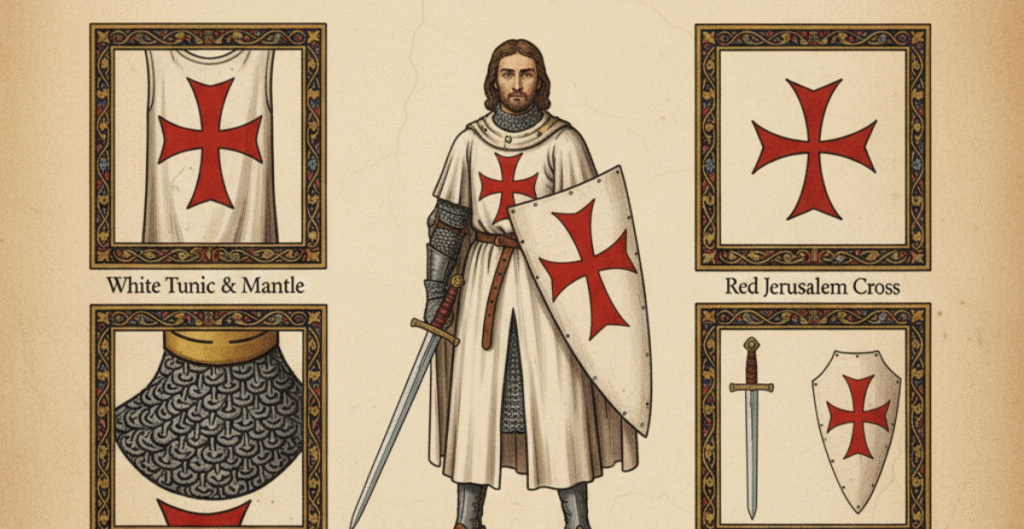
The medieval Knights Templar regalia consisted of more than just robes. The white tunic and mantle formed the base, always marked by the red cross. Knights also carried weapons such as swords and shields, which were not only practical tools for battle but also sacred objects.
Templars used official seals and insignia, including the famous image of two knights riding one horse, which symbolized humility and brotherhood. These seals stamped on letters and documents added an official identity to their possessions. Every element of the regalia carried both spiritual and symbolic weight.
See more: Masonic Apron – History, Meaning, and Modern Role
Symbolism Behind the Regalia
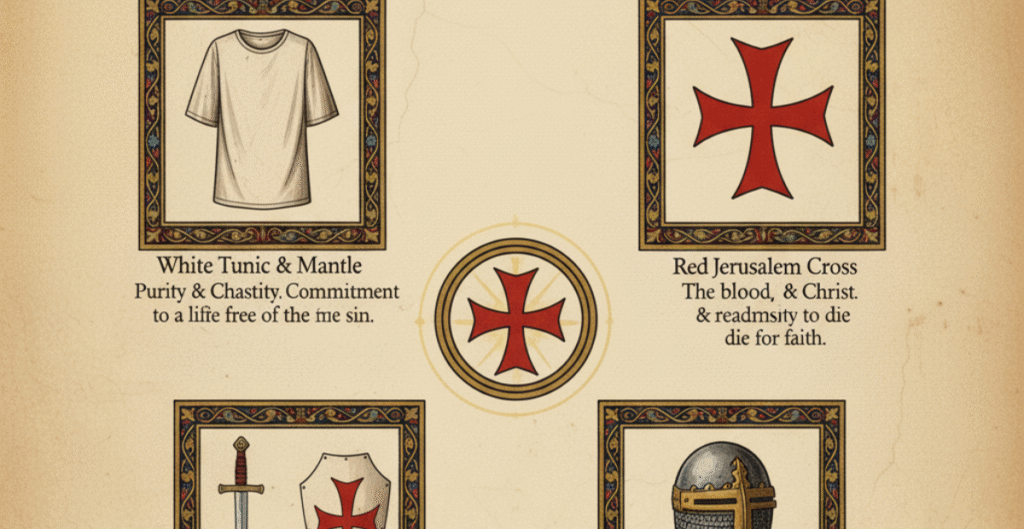
The symbolism of the Templar regalia was powerful. The red cross reminded the knights of Christ’s sacrifice and their readiness to give their lives for the faith. The white mantle spoke of chastity, loyalty, and a life devoted to spiritual purity.
Even the weapons held symbolic meaning. The sword represented the defense of Christianity, while the shield stood for protection of the weak. For the Templars, regalia was more than fabric or metal. It was a visible oath of their mission, binding them to their vows of poverty, chastity, and obedience.
Ceremonial and Religious Use in the Middle Ages
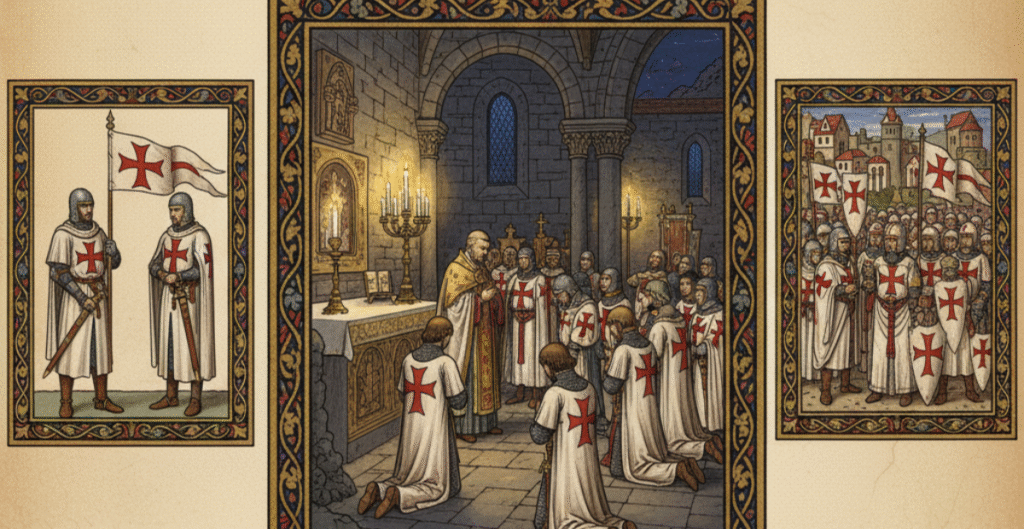
Templar regalia was worn during many important events. Knights wore it in battle to show unity and inspire fear in their enemies. They also wore it during religious ceremonies, processions, and while taking their vows.
The difference between battlefield attire and ceremonial garb was significant. In war, regalia was practical, while in religious services, it was worn with reverence. These garments created a strong sense of identity and belonging. It reminded both knights and followers that they were not only warriors but also monks.
Regalia and Ranks in the Medieval Templar Order
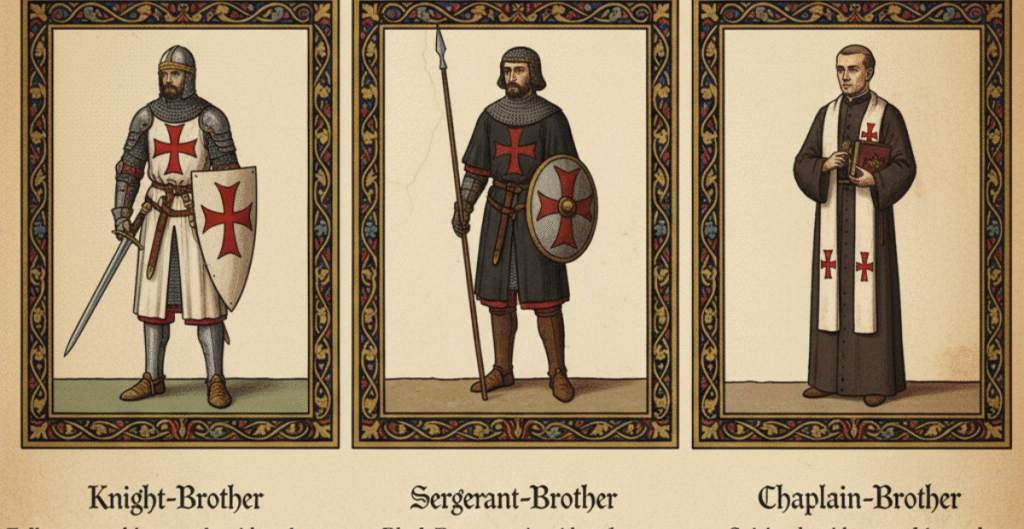
The regalia also reflected rank within the Order. Full knights wore the white mantle with the red cross, while sergeants often wore black or brown mantles with a smaller cross. Chaplains, who were priests, had simpler robes that reflected their spiritual duties.
The difference in clothing made hierarchy visible. Leaders often carried additional symbols such as staff or more decorated crosses. Regional variations existed too, but the essential elements of the white mantle and red cross always remained the heart of the regalia.
Decline and Dispersal of Original Templar Regalia
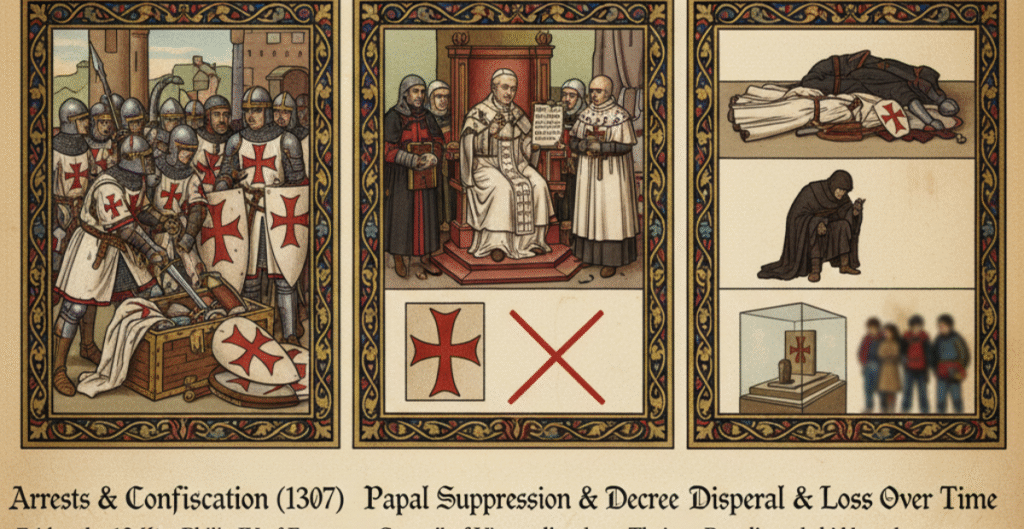
The fall of the Knights Templar in 1312 under Pope Clement V changed the fate of their regalia. Much of it was seized, destroyed, or lost. Surviving pieces became rare treasures, ending up in royal collections or later in museums.
Today, very few authentic medieval Templar garments exist. Most of what is displayed are later reproductions or symbolic items. However, these lost robes and weapons inspired countless later orders and remain central to the enduring Templar legend.
Regalia in Modern Templar-Inspired Orders
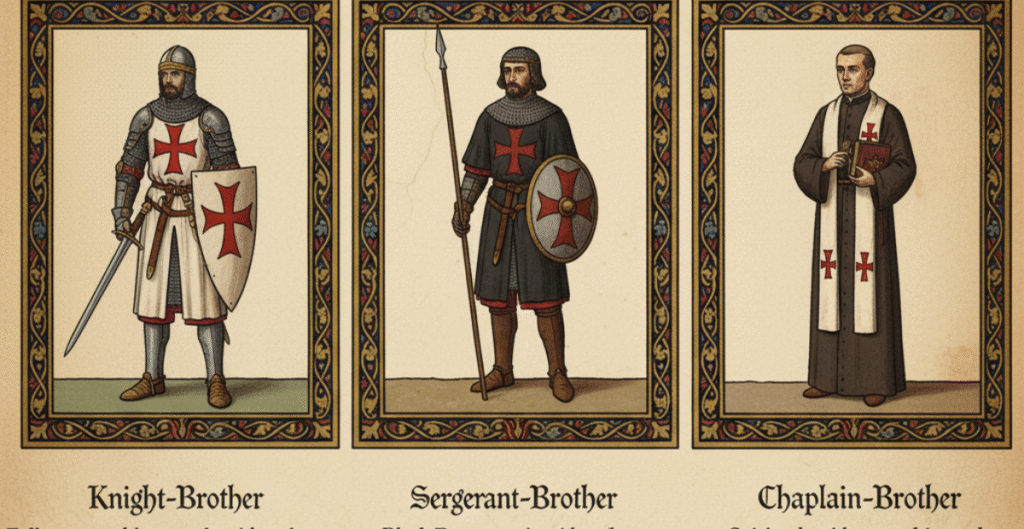
Centuries after their suppression, interest in Knights Templar regalia resurfaced. In the 18th and 19th centuries, fraternal and Masonic groups revived Templar traditions. Their regalia included mantles, swords, and elaborate insignia, often modeled on medieval designs.
In modern Christian and fraternal orders, regalia is still used in rituals, ceremonies, and gatherings. While not identical to the medieval originals, they serve the same purpose: to create unity, inspire loyalty, and connect members to the long Templar tradition.
Modern Symbolism and Cultural Influence
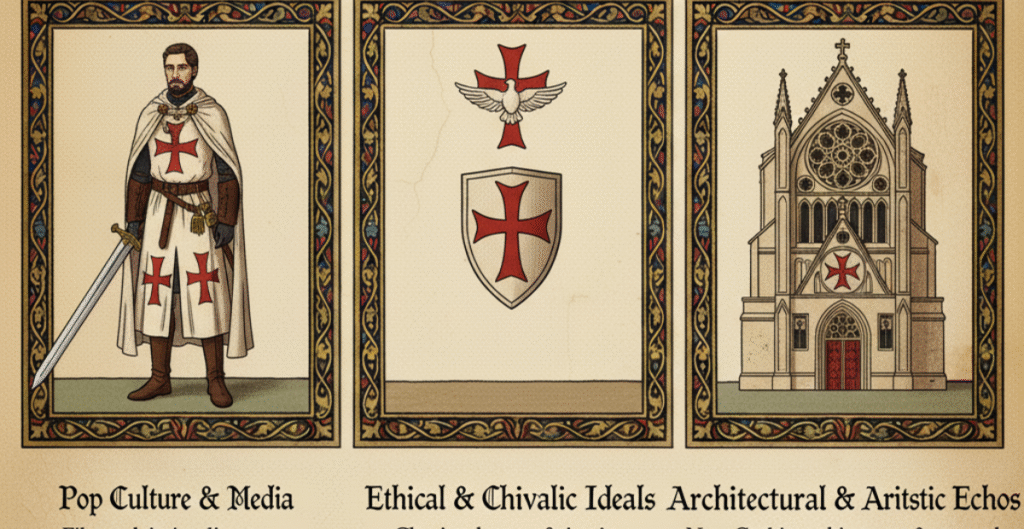
The regalia of the Templars continues to influence modern culture. Films, novels, and video games often feature knights in white cloaks with red crosses. This romanticized image, while not always historically accurate, keeps the Templars alive in popular imagination.
The lasting appeal comes from the mix of mystery, faith, and power attached to their regalia. Even today, the red cross remains a strong visual symbol, instantly linked to bravery and devotion. It shows how clothing can carry meaning across centuries.
Medieval vs Modern Templar Regalia
| Aspect | Medieval Regalia | Modern Regalia |
| Mantle | White with red cross | White, often more decorated |
| Weapons | Functional for war | Ceremonial only |
| Symbolism | Purity, sacrifice, defense of faith | Unity, tradition, fraternal ties |
| Materials | Wool, steel, leather | Modern fabrics and metals |
Collecting and Preserving Templar Regalia Today
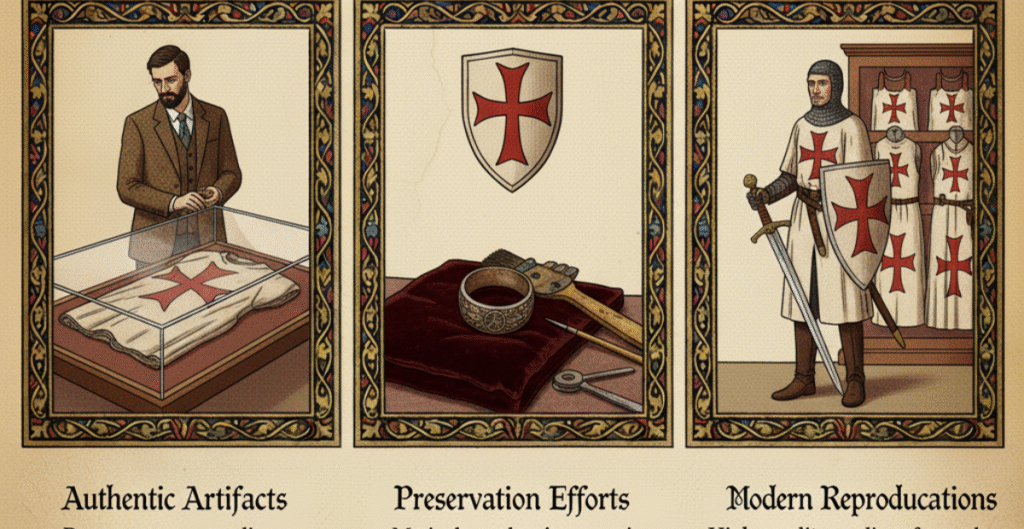
Collectors are still drawn to Templar regalia. Some chase genuine medieval artifacts, though they are extremely rare and costly. Others collect reproductions or items linked to later Templar-inspired orders. Museums display preserved swords, seals, and manuscripts that belonged to the order.
Preservation is vital. Textiles require careful storage away from light and moisture, while metal items need protection from rust. A table comparing original artifacts and modern reproductions helps clarify their value today.
| Type of Regalia | Original Templar (12th–14th c.) | Modern Reproductions | Value |
| Mantles & Tunics | Extremely rare, museum pieces | Widely available | Priceless / symbolic |
| Swords & Shields | Few originals exist | Many replicas sold | High historical value |
| Seals & Badges | Preserved in archives | Replica coins, seals | Historic/legal importance |
Legacy of Knights Templar Regalia
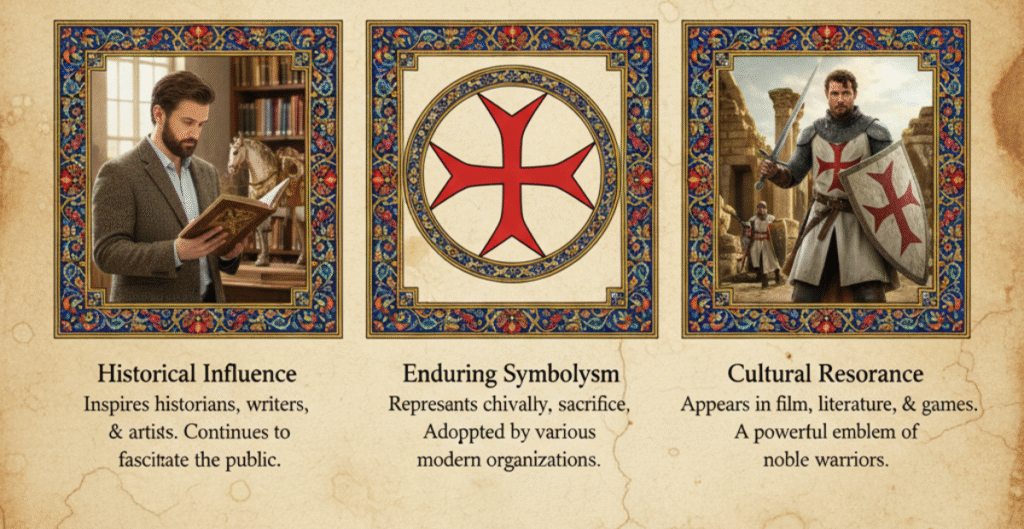
The legacy of Knights Templar regalia is undeniable. It connects history, faith, and legend in one image. These garments and symbols remind us of courage, sacrifice, and devotion that shaped medieval Europe.
Even centuries after the order’s fall, regalia continues to inspire curiosity. Whether displayed in museums, worn by modern fraternal orders, or imagined in popular culture, the white mantle with the red cross remains unforgettable. It shows how the past never truly disappears but lives on in the symbols we still recognize.
Case Study: A Surviving Templar Sword
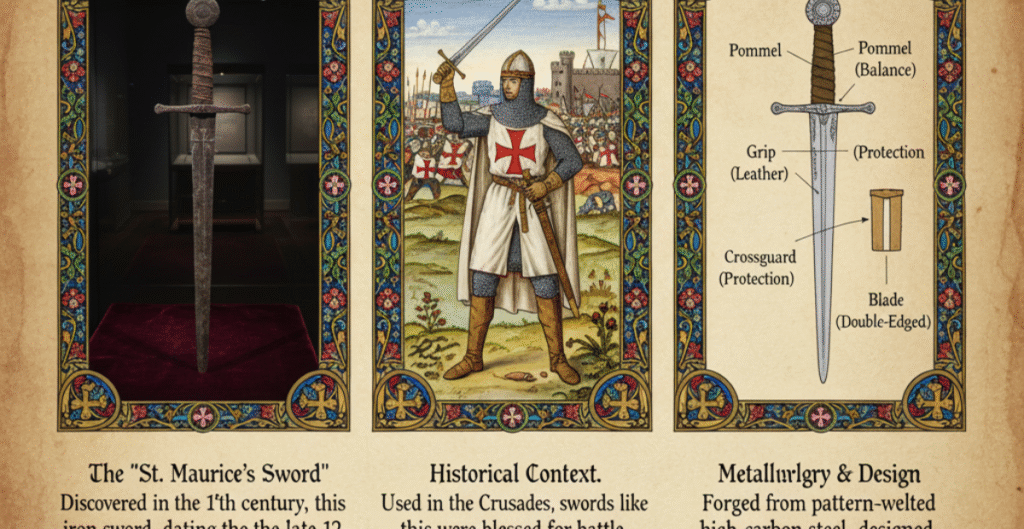
One of the most striking examples of preserved regalia is a sword believed to have belonged to a Templar knight. Found in the River Witham in England, it dates back to the 13th century. This sword is now displayed in the British Museum,
Offering a rare glimpse of authentic Templar weaponry. Its survival highlights how objects can carry stories across centuries, linking us directly to the knights who once held them.
You May like: Masonic Regalia: History, Symbolism, and Meaning in Freemasonry
Common Symbols in Templar Regalia
| Symbol | Meaning | Usage |
| Red Cross | Sacrifice and martyrdom | Mantle, shield |
| White Mantle | Purity and chastity | Worn by knights |
| Sword | Defense of faith | Battle and ceremony |
| Two Knights on One Horse | Humility and brotherhood | Official seals |
Influence of Templar Regalia on Heraldry
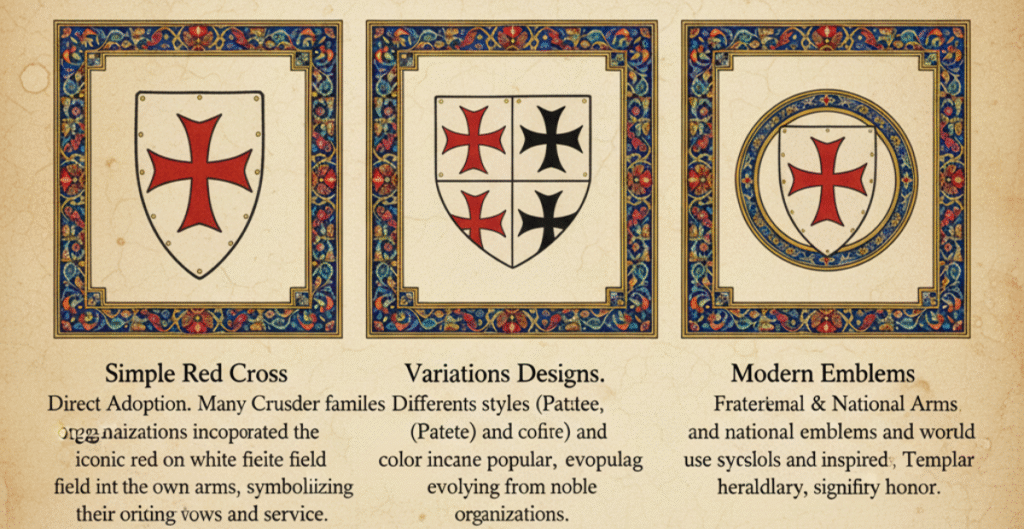
The Knights Templar regalia had a major impact on medieval heraldry. Many coats of arms across Europe began to use the red cross, swords, and other Templar-inspired symbols. These designs appeared on banners, shields, and family crests, linking noble families with the prestige of the order.
Even after the Templars were suppressed, the red cross continued to appear in heraldic designs. Over time, it became a common Christian emblem, carried into later crusading orders and royal insignia. The regalia’s influence stretched far beyond the battlefield, shaping the visual identity of kingdoms and noble houses.
Knights Templar Regalia in Popular Myths
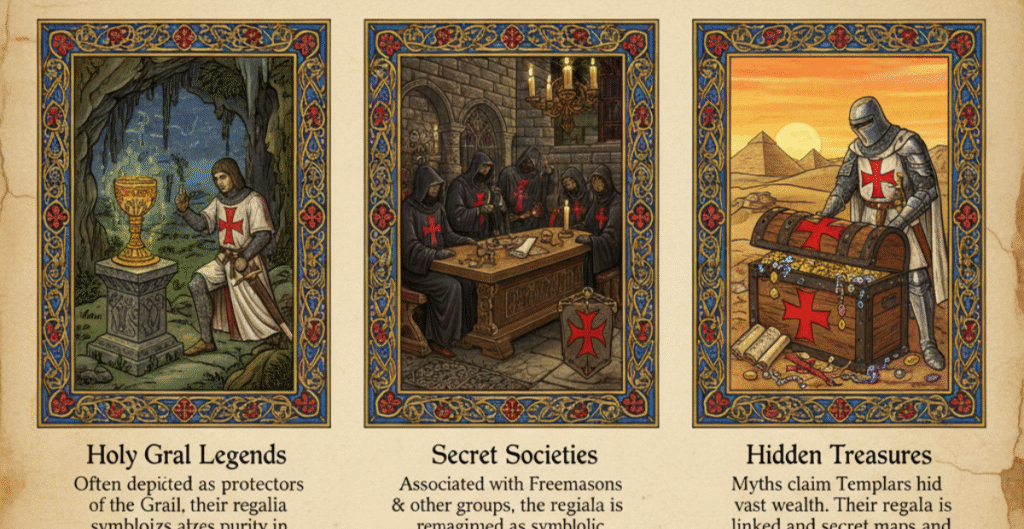
Stories about Templar regalia fueled many legends. Some tales claimed their mantles held magical powers or protection in battle. Others suggested their swords were blessed relics linked to the Holy Grail. These myths mixed history with imagination, making the regalia seem mysterious.
In modern times, novels and films spread these myths further. The image of the white cloak with the red cross became a symbol of secret knowledge, hidden treasure, and sacred duty. While historians separate fact from fiction, the myths continue to make the regalia more fascinating.
FAQ”s
What was the main uniform of the Knights Templar?
The main uniform was a white mantle and tunic with a red cross.
Did all Templars wear the same regalia?
No. Knights wore white mantles, while sergeants often wore darker colors.
Are there any original Templar garments left today?
Very few survive. Most original pieces are in museums or private collections.
Do modern Masonic Templars wear similar regalia?
Yes, they often wear mantles, swords, and insignia inspired by the medieval Templars.
Why is the red cross so important?
It symbolized sacrifice, martyrdom, and the Templars’ mission to defend Christianity.
Conclusion
The Blog Post Outline: Knights Templar Regalia is more than a study of clothing. It is a story of devotion, sacrifice, and identity that continues to echo through time. From the battlefields of the Crusades to the rituals of modern orders, the regalia tells us about faith, honor, and legacy. Even today, the red cross on a white mantle is one of the most powerful symbols of Western history, proving that the spirit of the Templars still lives on.




